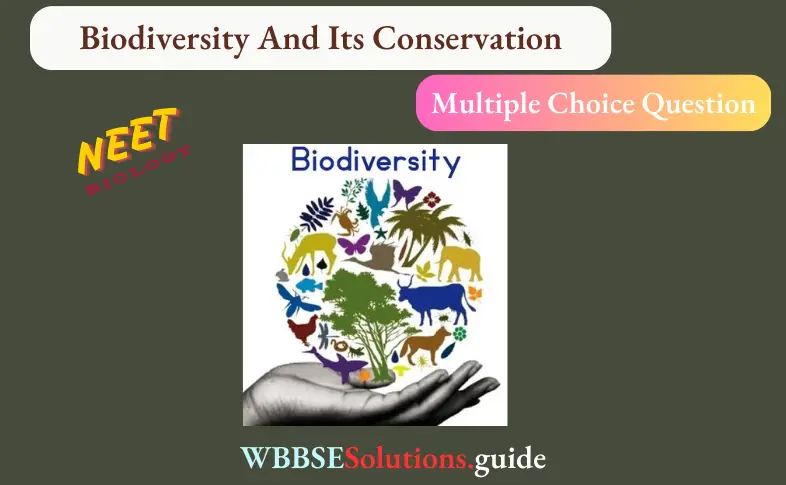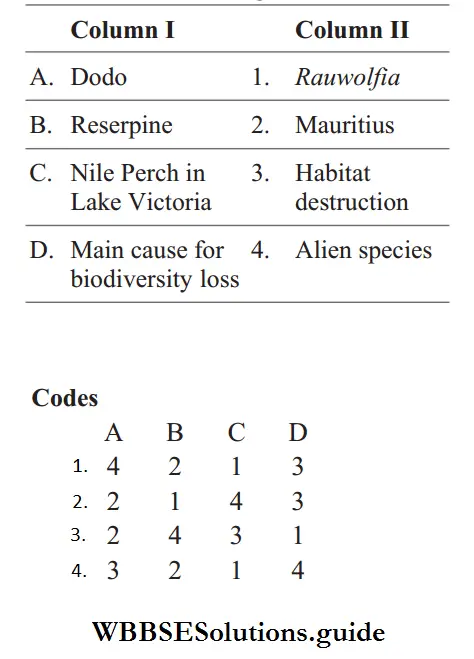NEET Biology Mcqs Biodiversity And Its Conservation Miscellaneous
Question 1. The major characteristics of the vegetation of a locality are controlled by
- Man Only
- Mainly By Climate
- Animals Only
- Altitude of place only
Answer: 2. Mainly By Climate
The vegetation of a particular locality depends upon the climatic conditions prevailing in the area.
Question 2. It is considered poor man’s timber.
- Mango wood
- Bamboo
- Acacia wood
- Eucalyptus wood
Answer: 2. Bamboo
Bamboos have thousands of economic applications, hence people call them ‘green gold’, ‘poor man’s timber’, ‘friend of the people’ and ‘cradle to coffin timber’.
Read And Learn More: NEET Biology Multiple Choice Question And Answers
Question 3. What is the animal symbol of WWF (World Wildlife Fund)?
- Dolphin
- Kangaroo
- Tiger
- Giant panda
Answer: 4. Giant panda
” viable material of endangered species can be preserved by”
The inspiration for the WWF logo came from Chi-Chi, a giant panda that was living at the London Zoo in 1961, the same year WWF was created. WWF’s founders were aware of theneed for a strong, recognisable symbol that would overcome all language barriers.

NEET Biology Biodiversity and Its Conservation MCQs with Answers
Question 4. The grasslands in Asia are known as
- Prairies
- Pampas
- Veldt
- Savannahs
Answer: 4. Savannahs
Savannahs are tropical grassland with scattered, drought resistant trees not exceeding 10 m in height. The grassland biome is found where rainfall is 25-75 cm per year. The largest areas of savannah are found in Africa, South America, Australia, India, Myanmar, Thailand and Madagascar.
Question 5. Match the following columns.

“biodiversity questions “
Answer: 2. A–2, B–1, C–4, D–3
Question 6. Which of the following is correctly matched?
- Aerenchyma – Opuntia
- Age pyramid – Biome
- Parthenium hysterophorus – Threat to biodiversity
- Stratification–Population
Answer: 3. Parthenium hysterophorus – Threat to biodiversity
Option 3 is correctly matched. Parthenium hysterophorus is an exotic or alien species which causes extinction of native or indegenous species.
NEET Biology Mcqs
Question 7. Which of the following statements is correct?
- Species diversity in general increases from poles to the equator
- Conventional taxonomic methods are equally suitable for higher plants and microorganisms
- India’s share of global species
diversity is about 18% - There are about 25,000 known species of plants in India
Answer: 1. Species diversity in general increases from poles to the equator
- Statement in option 1 is correct as Species diversity in general increases from poles to the equator. Other statements are incorrect and can be corrected as
- Conventional taxonomic methods are not equally suitable for higher plants and microorganisms. Microorganisms cannot be preserved easily and so cannot be classified easily.
- India has only 2.4% of the world’s land area its share of the global species diversity is an impressive 8.1%. So, it makes our country one of the megadiversity countries of the world.
- Nearly 45,000 species of plants and twice as many of animals have been recorded from India.
Miscellaneous MCQs on Biodiversity and Conservation for NEET
Question 8. Assertion The National Bird of New Zealand is Apteryx. Reason (R) Flightless birds are native of New Zealand.
- Both A and R are true and R is the correct explanation of A
- Both A and R are true, but R is not the correct explanation of A
- A is true, but R is false
- Both A and R are false
Answer: 1. Both A and R are true and R is the correct explanation of A
Both A are R are true and R is the correct explanation of A. Kiwi or Apteryx, flightless birds are native to New Zealand and is also the National, bird of New Zealand.
“biodiversity questions and answers pdf “
Question 9. Consider the following statements.
- The estuaries are semienclosed coastal body of water which has a free connection with the open sea.
- Estuaries may be considered as ecotones between the fresh and marine habitats.
- Estuaries are salt-water lakes.
- Estuaries are freshwater lakes.
Choose the option containing correct statements.
- 1 and 2
- 2 and 3
- 3 and 4
- 1, 2 and 3
Answer: 1. 1 and 2
Statements I and II are correct. An estuary is a partially (semi) enclosed coastal body of brackish water with one or more rivers or streams flowing into it, and with a free connection to the open sea. Estuaries form a transition zone between river environments and marine environments known as ecotone. Other statements are incorrect.
Different Aspects of Biodiversity and Its Conservation MCQs for NEET
Question 10. Which bird is the symbol of ‘The Bombay Natural History Society (BNHS)’?
- Hornbill
- Spoonbill
- Egret
- Sunbird
Answer: 1. Hornbill
The BNHS logo (symbol) is the great hornbill, inspired by a great hornbill named William, who lived on the premises of the Society from 1894 until 1920. Inquiline is an animal that lives in close association with another animal without harming it in any serious manner whereas a cultigen is a domesticated plant species of unknown or obscure origin, distinct in its characteristics from known natural species.
Question 11. Animals like cockroaches, lizards and mice share buildings of human dwellings. Such animals are
- Transgenic
- Endemic
- Inquilines
- Cultigens
Answer: 3. Inquilines
Animals like cockroaches, lizards and mice share buildings of human dwellings. Such animals are inquilines.
Question 12. Wildlife of Nature is renamed as
- World wildlife conservation of nature
- World wildlife of nature
- World wild fauna
- World wildlife fund
Answer: 4. World wildlife fund
World Wildlife Fund (WWF) was renamed as Wildlife of nature in 1986 which has a membership of about 23 countries including India.
“which one is an endangered species in the following “
Question 13. Choose the incorrectly matched pair.
- World Summit on Sustainable Development, 2002 – Johannesburg
- Carrot grass – Lantana
- Wildlife safari parks – Ex situ conservation
- Amazon rainforest – Lungs of the planet
- Khasi and Jaintia hills – Meghalaya
Answer: 2. Carrot grass – Lantana
Option 2 is incorrectly matched pair and can be corrected as Botanical name of carrot grass is Parthenium hysterophorus. Carrot grass belongs to family–Asteraceae and is native to subtropics of North and South America. Rest options are correctly matched pairs.
NEET Biology Mcqs
Question 14. Find the incorrectly matched pair.
- Endemism – Species confined to a region and not found anywhere else
- Hotspots – Western ghats
- Sacred groves – Jaintia Hills of Rajasthan
- Ex situ conservation – Zoological parks
- Alien species to India – Water hyacinth
Answer: 3. Sacred groves – Jaintia Hills of Rajasthan
Option 3 is incorrectly matched pair and can be corrected as Sacred groves are forest patches around places of worship which are held in high esteem by tribal communities.They are found in several parts of India, e.g. Karnataka, Maharashtra, Rajasthan (Aravalli), Meghalaya. In Meghalaya, sacred groves are found in Jaintia and Khasi hills. Rest options are correctly matched pairs.
NEET Biology Mcqs Chapter Wise
Question 15. Find the incorrectly matched pair.
- Endemism–Species confined to one region and not found anywhere else
- Hotspots – Regions with species richness
- Alien species to India – Clarias gariepinus
- Lungs of the planet – Amazon rainforest
- In situ conservation – IVF
Answer: 5. In situ conservation – IVF
Option 5 is an incorrectly matched pair and can be corrected as IVF is In Vitro Fertilisation, which is a method of assisted reproduction for infertile couples. In this method, fertilization is done outside the body in almost similar conditions as that in the body. It is not a method of in situ conservation. Rest options are correctly matched pairs.
Question 16. ‘One of the following statements is incorrect with reference to biodiversity. Identify it.
- The richest reservoirs of animal and plant life (high species richness) with few or no threatened species are called ‘biodiversity hotspots
- Biodiversity increases from higher altitudes to lower altitudes
- Biodiversity decreases from the equator to polar regions
- Depletion in the genetic diversity of crop plants is mainly due to the introduction of better varieties
Answer: 1. The richest reservoirs of animal and plant life (high species richness) with few or no threatened species are called ‘biodiversity hotspots
- The statement in option 1 is incorrect and can be corrected as Biodiversity hotspots are areas with a high density of biodiversity or megadiversity which are also the most threatened ones.
- They are determined by mainly three factors.
- Number of species/species diversity.
- Degree of endemism.
- Degree of threat to habitat due to its degradation and fragmentation. Rest of other statements are correct with reference to biodiversity.
